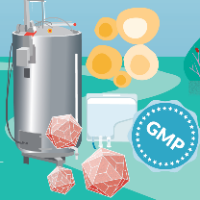Adeno-associated virus process development: optimization & development of a scalable elution for polishing chromatography
Cell & Gene Therapy Insights 2022; 8(3), 421 – 429
DOI: 10.18609/cgti.2022.061
In vivo gene therapy utilizing adeno-associated virus (AAV) is a rapidly developing and highly focused area of the biopharmaceutical industry. As the regulatory landscape is shaped there is an increased expectation for companies to develop manufacturing processes generating safe and efficacious AAV. A highly discussed and difficult aspect of AAV manufacturing is the separation of empty capsids from full capsids. Undesirable capsids have unknown impact on the patient’s immune system; consequently, it is desirable to remove them from the final product altogether and de-risk the potential impact to patient safety. From a process development perspective removal of undesirable capsids is challenging due to the similar quality attributes that are shared with full capsids. Anion exchange chromatography is often used as the final polishing step and is primarily used to separate empty capsids from full capsids. In order to achieve this separation a shallow increasing salt gradient with fractionation is used and these two modes of operation are not ideal for large scale manufacturing. Empty-full separation chromatography for a promising AAV8 construct underwent initial development and optimization for technology transfer to large-scale manufacturing at Precision BioSciences. This was accomplished by modifying the platform downstream process and screening both different elution conditions and resin modalities for improved resolution. The eluting peak order for this AAV8 construct is the empty capsid peak first followed by the full capsid peak and is then followed by a final impurity peak. Screening to improve resolution between the peaks created an opportunity to include an additional wash step that removes the empty capsid peak before elution occurs. This was accomplished without negative impact to product recovery and empty-full content. With the removal of the empty capsid peak the elution profile can be further optimized to not rely on a gradient fractionation at the manufacturing scale.
